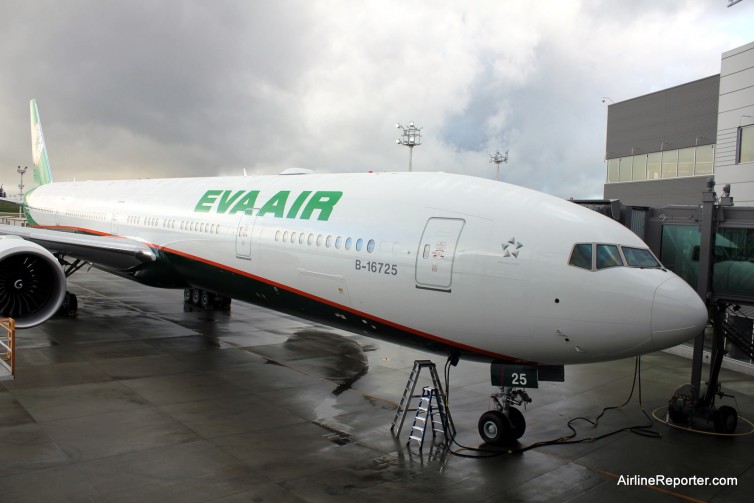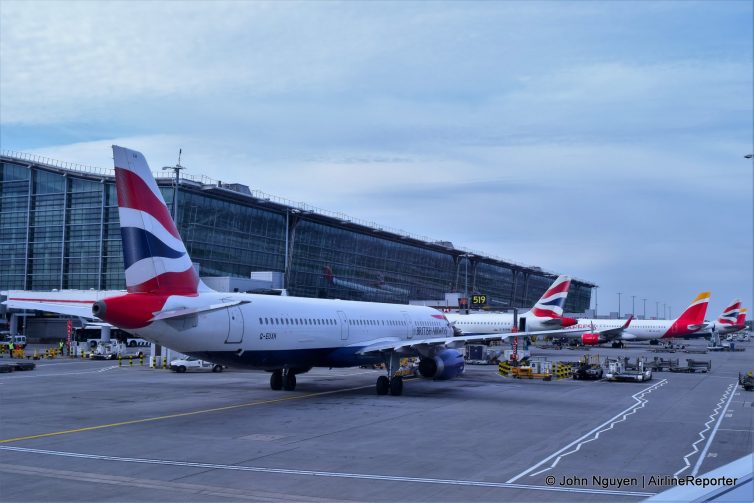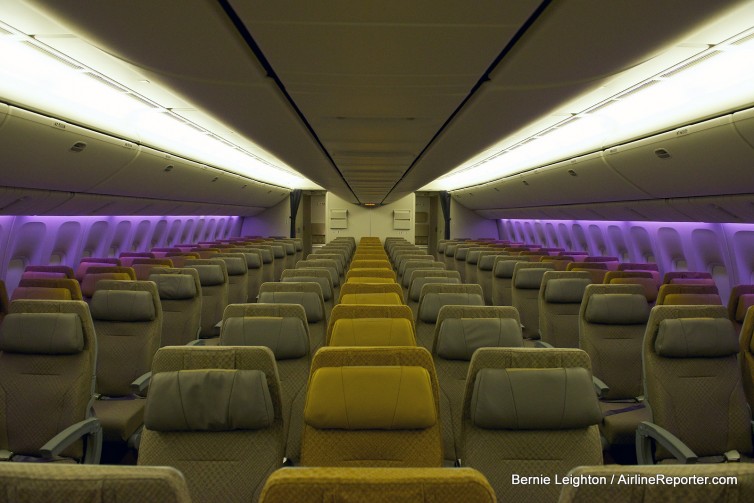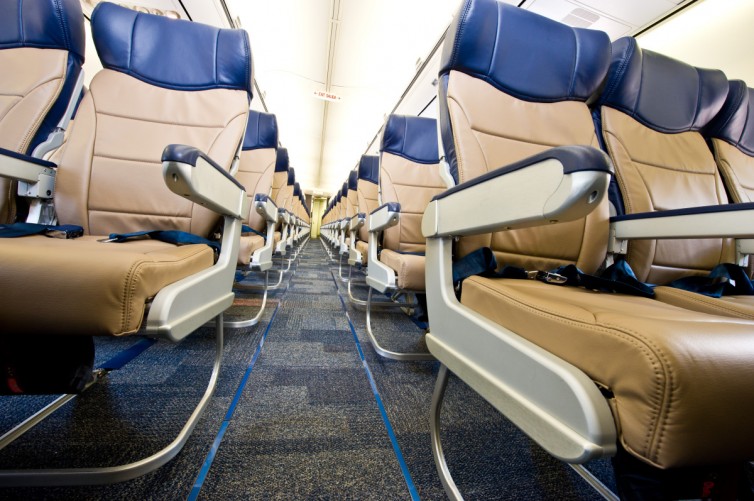I recently had the opportunity to fly both British Airways and Iberia in short-haul economy, and talk about a 180-degree difference, especially striking when both are owned by the same parent company. While short flights don’t generally get much consideration, when one carrier offers so much more than another on the exact same route (namely between London and Madrid) for the exact same price, it’s probably better to go with the airline that will offer more and avoid the one that (spoiler alert) won’t even give you water.
Browsing Tag: Seating

A brand-new EVA Boeing 777-300ER, currently the most popular 777 variant, at Paine Field (with nine-abreast economy)
In October 2015, it appeared that Cathay Pacific was ’˜flirting’ with the idea of changing its long-haul 777 economy class from a 9-abreast to a 10-abreast cabin. This appears to be correct, since Cathay Pacific gauged the responses of some of its most loyal Marco Polo customers in a recent survey to see whether they would accept a 3-4-3 configuration on their long-haul 777 aircraft.
BONUS: Flying a Cathay 777 Across North America in Business Class
’œTo understand the needs of our customers as well as the trend and development of the airline industry, Cathay Pacific periodically conducts research on different aspects of our offerings so as to continuously improve on our passenger services,’ Julie Jarratt, Cathay Pacific Communications Manager explained to AirlineReporter. ’œCathay Pacific, at this stage, has no decision to change the seat width and seat pitch of our 777 fleet.’
From an airline’s perspective, the rationale for a 10-abreast cabin is quite obvious. Not only does it provide a higher profit margin, by lowering its cost per seat mile, but it (theoretically) allows these savings to be put into other benefits for travelers in the form of cheaper airfares or enhanced services. In this sense, a denser cabin allows airlines to move greater numbers of passenger on fewer flights, which leads to fuel efficiency in the form of equated fuel burn reduction savings. I wanted to take a closer look at which airlines are taking delivery of the higher-density 777s, as that configuration is becoming more and more popular.
Love it or hate it, Southwest Airlines has a unique seating process. Where most airlines will assign you an exact seat, Southwest gives you a boarding number and you can choose any open seat on the plane. Some enjoy choosing who they sit next to, but others don’t like the added anxiety of not knowing where you will sit until you are on the plane. I wanted to run down some ideas on how to get the best seat possible on a Southwest Airlines flight. They have seemed to work out pretty darn well for me over the years.
If you haven’t flown Southwest before, it can be a little confusing. When you check in, you will get a boarding letter – A, B or C – and a number – 1-60. A1 is the best and C23 (on a 737-700) / C55 (on a 737-800) is the worst. No matter what number you have, there are ways to improve where you sit — unless you are last to board.
 Airbus versus Boeing. Who doesn’t love a good competition between the world’s two largest commercial airline manufactures? I try to say I am not slanted one way or another, but living 15 minutes away from where most Boeing aircraft are made might make me a bit biased. The saying around these parts, “If it isn’t Boeing, I am not going,” is pretty popular. I actually know a few people who honestly will not fly an Airbus or Boeing product just on principle. I don’t go that far.
Airbus versus Boeing. Who doesn’t love a good competition between the world’s two largest commercial airline manufactures? I try to say I am not slanted one way or another, but living 15 minutes away from where most Boeing aircraft are made might make me a bit biased. The saying around these parts, “If it isn’t Boeing, I am not going,” is pretty popular. I actually know a few people who honestly will not fly an Airbus or Boeing product just on principle. I don’t go that far.
Anyhow one of the constant “this manufacture is better,” arguments I hear is that the Airbus A320 seats are so much wider than the B0eing 737s. I figured it was time to find out. I took a look at airlines from around the world that fly both aircraft and used SeatGuru.com to find out the width of each seat.
I wanted to check the accuracy of the information SeatGuru has on their site, so I spoke with Jami Counter, Senior director of the site and he stated, “SeatGuru’s content team utilizes flyer comments to maintain the accuracy of our airplane seat information and updates the site with both user-submitted reviews and independent research.” That being said, I am by no means saying this is 100% scientific, but I think it can give a good comparison between the two.
Both the Airbus A320 and Boeing 737 families have the same width no matter what model they might be (ie a Boeing 737-200 is just as wide as a -900). Airbus starts out ahead with a fuselage width of 156″ and a cabin width of 146″. The Boeing 737 is a bit smaller with a 148″ fuselage and only 139″ in the cabin. This means that the Airbus A320 has 7 more inches of width than the Boeing 737. If an airline did things right, each seat and the aisle could have 1″ more width than the 737.
I took a look at airlines running the Boeing 737 and/or the Airbus A320. I compared both the standard economy seating and also premium seating (some airlines call it first class, business, etc). The economy is shown with an “E” and premium with a “P.” If an airline had multiple seat widths in the same category, I averaged them together. Here are my results in inches:
On average, the Airbus A320 seats are wider, but not by much. Only about 1/2″ in economy and almost no difference with premium seats. It seems that airlines and seat manufactures are not using that extra 7″ of cabin width that the Airbus A320 provides.
When I asked Counter from SeatGuru about his thoughts, he told me, “While the A320 does have a wider diameter fuselage, it doesn’t necessarily mean that airlines will put in a significantly wider seat.” He also took a look at the data they have on their site and came to a similar conclusion that the A320 will have slightly more width on average. “On SeatGuru we’ve found that while there is some variation, we generally see airlines give about 17-17.2″ seat width in coach on a B737, while they give about 17.5″-18″ seat width in coach on an A320. These differences depend on the types of seats airlines use, as well as the overall seating configuration of the aircraft. ”
Is it worth making an effort to fly on a Airbus A320 for more room? I am going to say no. I know that many people have a preference of aircraft type they fly on and I am assuming that fractions of an inch isn’t going to persuade a person one way or another. However, airline loyalist have always surprised me in the past. Does this information change your views on flying on either the Boeing 737 or Airbus A320?
Orig Image: Caribb


